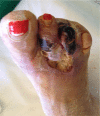Current concepts for the evaluation and management of diabetic foot ulcers
- PMID: 30305936
- PMCID: PMC6174858
- DOI: 10.1302/2058-5241.3.180010
Current concepts for the evaluation and management of diabetic foot ulcers
Abstract
The lifetime risk for diabetic patients to develop a diabetic foot ulcer (DFU) is 25%. In these patients, the risk of amputation is increased and the outcome deteriorates.More than 50% of non-traumatic lower-extremity amputations are related to DFU infections and 85% of all lower-extremity amputations in patients with diabetes are preceded by an ulcer; up to 70% of diabetic patients with a DFU-related amputation die within five years of their amputation.Optimal management of patients with DFUs must include clinical awareness, adequate blood glucose control, periodic foot inspection, custom therapeutic footwear, off-loading in high-risk patients, local wound care, diagnosis and control of osteomyelitis and ischaemia. Cite this article: EFORT Open Rev 2018;3:513-525. DOI: 10.1302/2058-5241.3.180010.
Keywords: diabetic foot ulcers; infection; osteomyelitis; revascularization; wound dressings.
Conflict of interest statement
ICMJE Conflict of interest statement: None declared.
Figures





Similar articles
-
The management of diabetic foot: A clinical practice guideline by the Society for Vascular Surgery in collaboration with the American Podiatric Medical Association and the Society for Vascular Medicine.J Vasc Surg. 2016 Feb;63(2 Suppl):3S-21S. doi: 10.1016/j.jvs.2015.10.003. J Vasc Surg. 2016. PMID: 26804367
-
Poorly designed research does not help clarify the role of hyperbaric oxygen in the treatment of chronic diabetic foot ulcers.Diving Hyperb Med. 2016 Sep;46(3):133-134. Diving Hyperb Med. 2016. PMID: 27723012
-
Variation in clinical presentation of hospitalized patients with diabetic foot ulcers who underwent lower leg amputation in the Bronx from 2016-2021.Endocrinol Diabetes Metab Case Rep. 2025 May 20;2025(2):e250036. doi: 10.1530/EDM-25-0036. Print 2025 Apr 1. Endocrinol Diabetes Metab Case Rep. 2025. PMID: 40396336 Free PMC article.
-
Current scenario of traditional medicines in management of diabetic foot ulcers: A review.World J Diabetes. 2023 Jan 15;14(1):1-16. doi: 10.4239/wjd.v14.i1.1. World J Diabetes. 2023. PMID: 36684382 Free PMC article. Review.
-
Systematic reviews of wound care management: (3) antimicrobial agents for chronic wounds; (4) diabetic foot ulceration.Health Technol Assess. 2000;4(21):1-237. Health Technol Assess. 2000. PMID: 11074391 Review.
Cited by
-
Diabetic Foot Ulcers: Current Advances in Antimicrobial Therapies and Emerging Treatments.Antibiotics (Basel). 2019 Oct 24;8(4):193. doi: 10.3390/antibiotics8040193. Antibiotics (Basel). 2019. PMID: 31652990 Free PMC article. Review.
-
ENERGI-F703 gel, as a new topical treatment for diabetic foot and leg ulcers: A multicenter, randomized, double-blind, phase II trial.EClinicalMedicine. 2022 Jul 10;51:101497. doi: 10.1016/j.eclinm.2022.101497. eCollection 2022 Sep. EClinicalMedicine. 2022. PMID: 35844773 Free PMC article.
-
Gentiopicroside targeting AKT1 activates HIF-1α/VEGF axis promoting diabetic ulcer wound healing.Front Pharmacol. 2025 Feb 26;16:1506499. doi: 10.3389/fphar.2025.1506499. eCollection 2025. Front Pharmacol. 2025. PMID: 40078292 Free PMC article.
-
Characteristics of Diabetic Foot Ulcer Patients Pre- and During COVID-19 Pandemic: Lessons Learnt From a National Referral Hospital in Indonesia.J Prim Care Community Health. 2022 Jan-Dec;13:21501319221089767. doi: 10.1177/21501319221089767. J Prim Care Community Health. 2022. PMID: 35343835 Free PMC article.
-
Validity and reliability of the German translation of the Diabetes Foot Self-Care Behavior Scale (DFSBS-D).PLoS One. 2022 Jun 3;17(6):e0269395. doi: 10.1371/journal.pone.0269395. eCollection 2022. PLoS One. 2022. PMID: 35657819 Free PMC article.
References
-
- Peter-Riesch B. The diabetic foot: the never-ending challenge. Endocr Dev 2016;31:108-134. - PubMed
-
- National Institute for Health and Care Excellence. Diabetic foot problems: prevention and management (NG19). London: NICE, 2015. https://www.nice.org.uk/guidance/ng19 (date last accessed 9 February 2018). - PubMed
-
- Brownrigg JR, Davey J, Holt PJ, et al. The association of ulceration of the foot with cardiovascular and all-cause mortality in patients with diabetes: a meta-analysis. Diabetologia 2012;55(11):2906-2912. - PubMed
LinkOut - more resources
Full Text Sources

